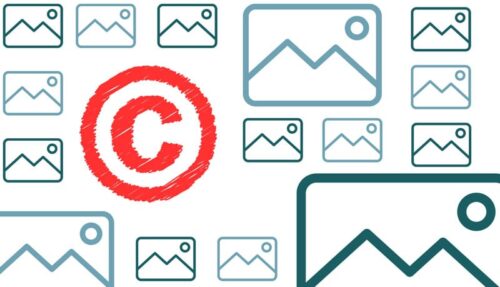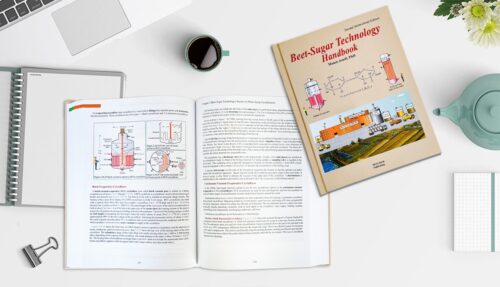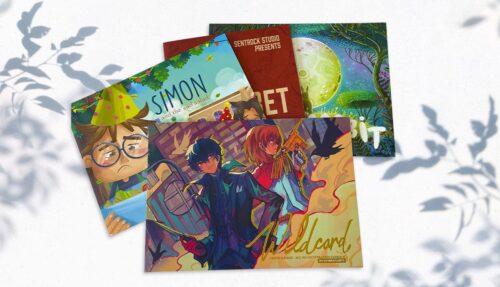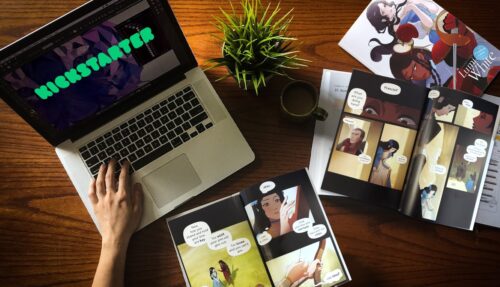EBooks have entered into the mainstream publishing ecology and are enormously popular, especially with millennials; but the most recent statistics show that publishers, booksellers, and readers still prefer printed books even when an eBook version is available
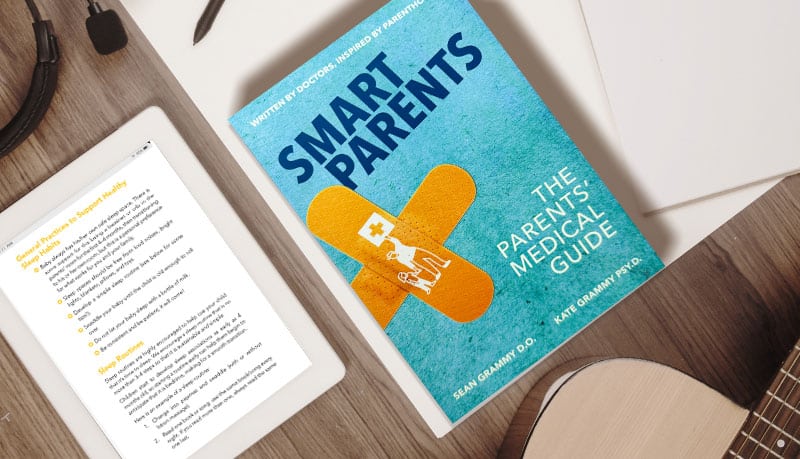
Physical books still represent the lion's share of the publishing market
Since the eBook first emerged on the market, the controversy has raged on among readers, publishers—both indie and mainstream—and authors and designers: which is better, the digital read or the traditional printed book? It’s the eBook vs. paperback debate. But while the argument may still seem hot in some sections of the media and on reader/writer/book blogs and vlogs the world over, things have settled down a great deal now and the facts tell a less contentious story. eBooks are part of the mainstream and the sale of e-readers—kindles, kobos, and the old nooks, or equivalent apps for phones—have plateaued and leveled off. So, the eBook has found its place. But most people, it seems, still prefer to read a physical book when they have the choice.
According to The Association of American Publishers, in 2023, 55% of book publishing’s market share was in print books (hardcovers, paperbacks, mass market, and special bindings), and 16% was in digital formats (Digital Audio and eBooks). In the consumer books market, 72% are printed books.
By contrast, according to the latest analysis from Statista (using more recent data from 2020 to 2023) the market share for paperbacks is almost 40%, with hardbacks coming in at just over 30% of all book sales. Interestingly, audiobook sales have increased whereas eBook sales have dropped significantly. So, most book sales are still in print books and of those the lion’s share goes to paperbacks. There was some speculation that this figure may be unusually high because of the pandemic that kept people all over the world at home and left many stores closed for months at a time but there’s no evidence to support the idea as the book market continues to thrive even now that the pandemic is over for most of the world’s population. The same analysis from the AAP that 39% of American adults say they only read printed books; a mere 7% only read digital formats(eBooks and PDFs), and 29% read both.
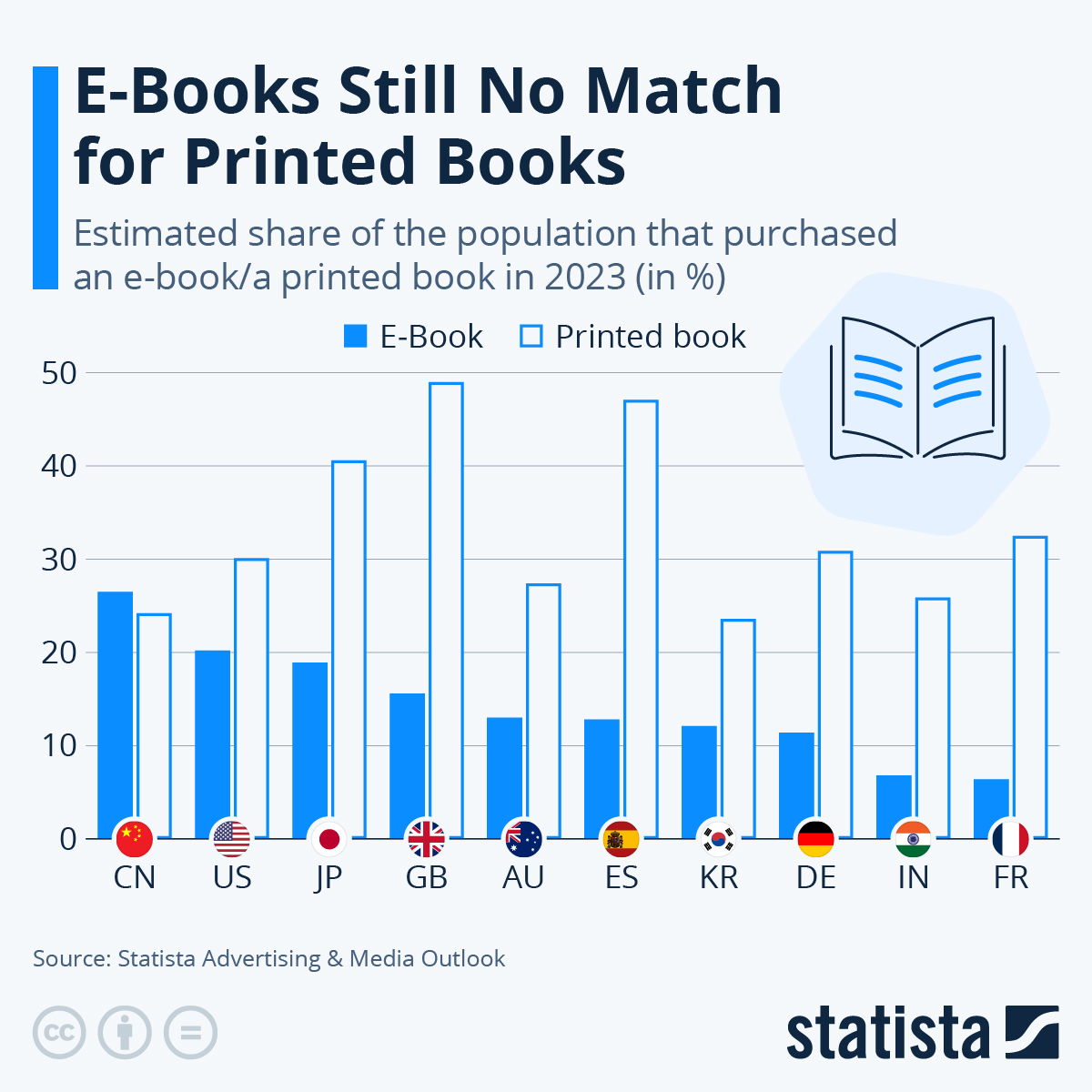 You will find more infographics at Statista
You will find more infographics at Statista The so-called “digital revolution” has definitely proved problematic for several branches of the print industry: newspaper sales have plummeted as most people find their news online, for example, and most business newsletters are now digital. But the physical, printed book not only endures: it goes from strength to strength. Given the perceived convenience of the ‘10,000-books-in-your-pocket’ e-reader and the lower price point, why should that be?
The physical object itself is, without doubt, an important factor. A book is more than a channel of communication; it’s an experience. You know, nutrition pills were developed for astronauts decades ago, but who prefers popping a nutritional pill to sitting down with friends for a leisurely lunch prepared by a skilled chef? In the same way that eating isn’t just about nutrition, reading isn’t just about information.
People love physical books: their texture, weight in the hand, the subtle whisper of turning pages, their aroma. And not only that. Publishers are creating incredibly beautiful books these days. Cover art, layout, fonts, drop capitals, dividers, all contribute to books which are works of art in their own right, embodying value even before you read them. They look good on your bookshelves at home. They express something of your personality, your cultural values, your sense of self. And they display those messages to the world, to your family, friends, and colleagues. That’s something with which no eBook, however neatly coded, can ever compete.
While it’s commonly thought that digital reading is more popular with the younger crowd and the older folks prefer a classic printed reading experience, the statistics suggest the exact opposite is true. It’s people under forty who are driving printed book sales and the Gen X crowd and the Boomers who have adopted the eReader. No doubt, the ability to turn pages despite reduced dexterity and to enlarge text is a factor in this preference.
Whether you prefer to read in an electronic format or in print, one thing’s for sure; print books and publishing have a secure future. People still need to access information and they still want to read stories. While that continues to be true, there will always be printed books. And despite their convenience for certain applications, eBooks have severe limitations and we — the reading public — much prefer a ‘proper book’ most of the time; eBooks may complement printed books, but they’re not set to replace them anytime soon.
eBooks vs. print books: what are the differences?
So, in our discussion of the market statistics for books sales, we’ve touched on a few factors which differentiate eBooks and paperback books from one another—over and above the obvious material characteristics. Now let’s look a bit more deeply into what these differences are and what they mean for readers and publishers (or self-publishers) alike.
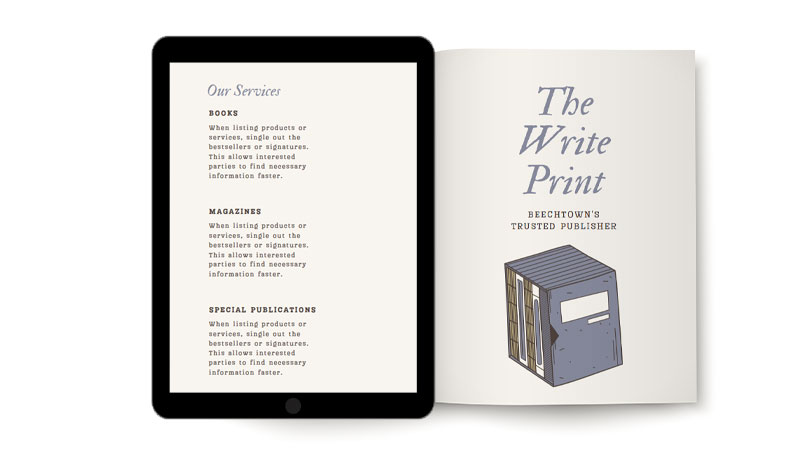
How does a paperback book and an eBook differ?
Paperback books — and, indeed, hardcover books — are physical, printed editions, ink-on-paper with the pages bound together. They may contain only text or text and images, too. The images may be photographs or illustrations and may be black-and-white, gray-scale, or full color. Whereas eBooks are digital files which can be read on-screen either via an application on a device such as a desktop computer or a smartphone, or on a purpose-made e-reader. The most common file types are pdf, mobi, and ePub. The Kindle, the Nook, and the Kobo are the most popular e-readers.
Pros and cons of eBooks and print books
There are advantages and disadvantages to both printed books and eBooks. It’s really not a binary choice between one or the other. Each has its place in the modern reading ecology. But let’s take a look at a few of the pros and cons:
Print book pros:
- Printed books, paperback and hardback, have a physical feel to them that most readers prefer
- Illustrations and photographs reproduced on good paper stock and using the latest print technology are clearer and the colors truer
- Readers like to keep physical books and display them at home on their bookshelves
- They can be made from sustainable materials and recycled
- Off-screen reading is less of an eye-strain
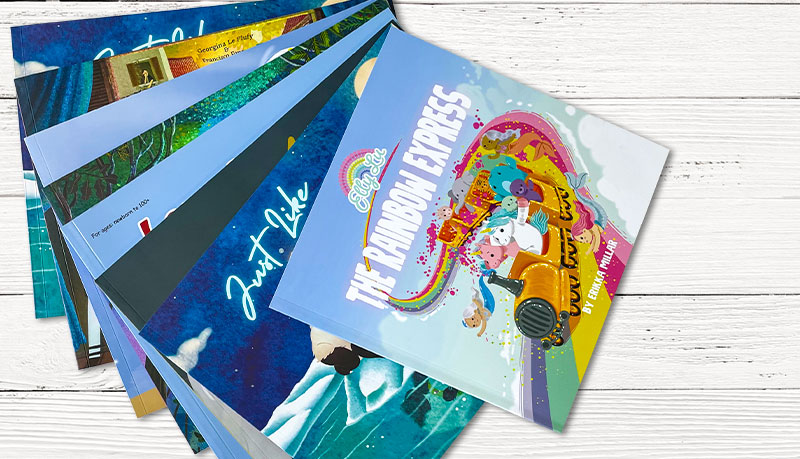
Print book cons:
- Printed books sometimes cost more than their electronic equivalents
- They are more inconvenient to deliver and store
eBook pros:
- E-readers are lightweight and easy to carry around compared to some print books
- You can keep a library of several thousand eBooks in your pocket
- Once you’ve made the capital outlay to buy the e-reader, the books themselves are often — although not always — cheaper and may even be free
eBook cons:
- Illustrations are usually poor and charts, tables, and graphics are often indecipherable
- The production of e-readers — like smartphones — is resource-heavy and damaging to the environment; they can’t be recycled
Are eBooks cheaper than print books?
Yes and no! It was thought back in 2015 (more-or-less the advent of the eBook as we know it today) that the relatively cheap cost of buying and reading such books would consign the printed book to the museum. Well, are they really cheaper? Some eBooks are free. Others are cheaper than the print versions. But the reality is that increasingly often print versions and electronic editions are almost, if not the same, in price. And many self-published books in certain popular sub-genres only have an eBook version. Stores like Amazon may run special promotions on eBooks from time-to-time, but all stores do that, on- and offline, with electronic and print books. There’s no hard-and-fast rule. It all depends on the publisher, the marketing strategy, the genre, how famous or unknown the author is, and several other factors.
But let’s be clear: the idea that eBooks are always cheaper isn’t true. And you must buy, charge, and update your e-reader in order to read eBooks. With a physical book, you don’t need software, a device, batteries, or anything else: you just open it and start reading!
eBooks vs paperbacks: the publisher's perspective
Most self-publishers favor eBooks because they’re perceived as cheap and relatively easy to put into the marketplace. Although we suspect that if they knew just how small the market for eBooks is and how much of the market they’re missing by skipping print editions, that might be surprised if not shocked. Traditional publishers — perhaps having initially seen the e-reader as a threat — took a little longer to adopt electronic publishing. As time goes on, however, it seems that we can expect increasing hybridization until self-publishing and mainstream publishing are divided only by a blurry line with plenty of crossover in-between.
But is it really cheaper to publish eBooks only, especially as a self-publisher? Not really. While you obviously don’t have printing costs, you still need to pay for editing, formatting, and artwork; not to mention ISBNs (if you want to publish off Amazon and get your books into libraries’ digital databases), marketing, and promotion. And where you may save on one side, you pay more on the other. For example, as we’ve seen, few readers are e-reader exclusive. So, the word on self-publishing street these days is that you must publish a paperback edition anyway or you’re effectively cutting down your market share to less than 10%. If you choose not to have a print edition — say, if you go with KDP Kindle exclusive publishing — then you’re competing in a very narrow field and your marketing budget will probably go up. From this perspective, it always makes more sense—both in terms of marketing potential and profitability—to publish a print edition of all your books.
eBook vs. paperback: 5 common questions answered
So, having made a general assessment of the situation, looked at arguments for and against both formats, and examined the data and statistics, let’s answer some of the web’s five most common questions around the eBook vs. paperback debate. If you have more questions, ask them in the comments section below and we’ll answer you personally there.
1. Which is better, eBook or printed book?
Many studies — several cited in a fascinating article published in Scientific American — show that the brain responds differently to digital reading and reading print. In fact, there’s no conclusive evidence to suggest that we understand more and retain information in memory for longer when we interact with a traditional printed medium as opposed to a digital one.
Most people in the surveys that we quoted earlier also say that they enjoy the experience of a physical book more than an eBook. Because many people aren’t just readers but ‘book lovers’ and the reading experience for them isn’t just about the words; and the multi-sensory richness of the physical, printed book beats even the most expensive e-reader on this metric.
So, while eBooks have their place on balance, the market and people’s buying habits suggest that the paperback, or hardback, is still thought to be the best way to read for most people, most of the time.
2. What are the disadvantages of eBooks?
eBooks pose several disadvantages over printed books:
- There’s the expense — hundreds of dollars — to buy the e-reader in the first place
- Then you need to keep recharging the battery and replace it when it gives up the ghost
- You need a fast, reliable Internet connection to download your books
- Technical issues, poor connectivity, software updates, and more can all interrupt the reading experience
- Even now, according to this article in The Atlantic, the eBook is dominated by the self-publishing movement. Relatively few traditionally published authors’ books are available in electronic format if they were published after 1932. Which means that to find something good to read, you need to plow through all the not very good stuff published without any quality control; and if you’re looking for a favorite mainstream author, you probably need to get the paperback.
3. Is reading e-Books worse than reading paper books?
Most studies — like the ones cited in the Scientific American article we mentioned above — show that the electronic reading experience is less engaging, less memorable, and worse for your eyes. So, in that sense, yes, reading eBooks is worse than reading printed paper books.
4. Do eBooks outsell print books?
The short and sweet answer is that — evidenced in data from Publishers Weekly, Statista, and The Association of American Publishers, to name only a few reliable sources — no, eBooks don’t outsell print books. The printed paper book still dominates the market.
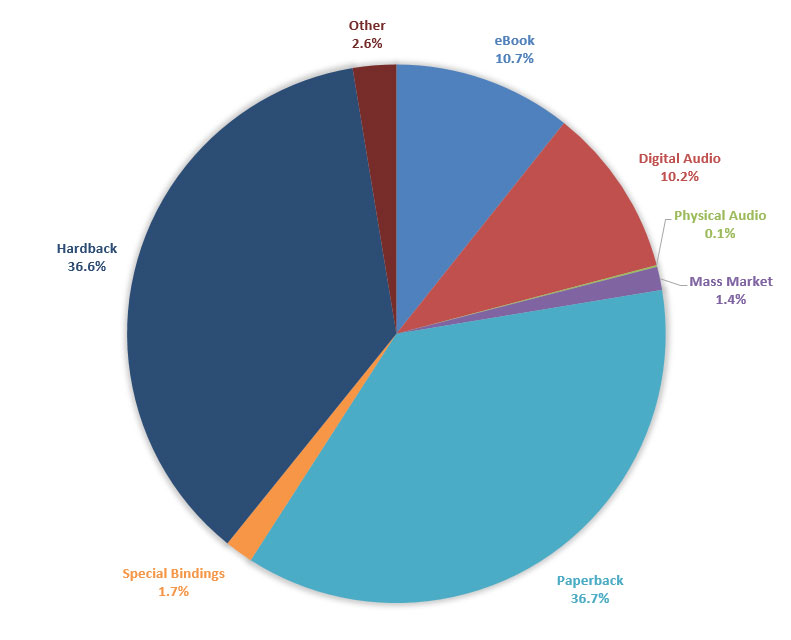
5. Can eBooks replace paper books?
In theory, it might be possible for eBooks to replace certain kinds of printed books such as genre fiction like romance, SF, crime, thrillers, mysteries, and so on. Although it’s unlikely. If that was going to happen, the eBook’s had 10 years and more to take over the paper book and show no signs of doing so. Other books — text books, art books, scientific books, technical books, and specialist books of every kind — don’t lend themselves to electronic publishing at all. The format, image reproduction size and quality that these books need can’t be provided by any e-reader. So, it looks like e-books are here to stay — as an often handy and convenient complement to the printed book — but they won’t replace paper books.
The future of printed books
So, the future of printed books is secure. Whether a reader, a collector, a writer, a publisher or self-publisher, you’ll find that your e-reader may be useful, but it’s never going to become a definitive alternative to a paperback, a hardcover, or any other format of printed book. The paper book is here to stay.
Thinking of printing your own book?
You needn’t be a career self-publisher or the director of a mainstream publishing house to print a book — although if you are either of those things, we should talk! — as people choose to print books for many reasons. Novels, memoirs, cookbooks, fine art and photography books, coffee-table books, children’s picture books, board books, pop-up books, comics and graphic novels, manga and more, are all popular book printing projects. Whatever your reason for printing, talk to us first. We have three decades of success in the international offset printing industry, state-of-the-art technology in our superb facilities in Shanghai, and a deep and sincere commitment to excellent, personalized customer service. Get in touch today and our friendly expert printers will be happy to discuss your project, and give you a quote, with no obligation on your part. Shoot us an email to [email protected] or call us on +1 951 866 3971 (remembering potential time zone differences!) and we’ll be delighted to discuss your needs, answer your questions, and help in any other way we can.






